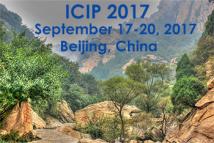
The International Conference on Image Processing (ICIP), sponsored by the IEEE Signal Processing Society, is the premier forum for the presentation of technological advances and research results in the fields of theoretical, experimental, and applied image and video processing. ICIP has been held annually since 1994, brings together leading engineers and scientists in image and video processing from around the world. Visit website.
In many real life application measured data takes its values on Riemannian manifolds. For the special case of the Euclidean space this setting includes the classical grayscale and color images. Like these classical images, manifold-valued data might suffer from measurement errors in form of noise or missing data. In this paper we present the manifold-valued image restoration toolbox (MVIRT) that provides implementations of classical image processing tasks.
- Categories:
 129 Views
129 Views- Read more about Image Quality Assessment to Enhance Infrared Face Recognition
- Log in to post comments
Automatic quality evaluation of infrared images has not been researched as extensively as for images of the visible spectrum. Moreover, there is a lack of studies on the influence of degradation of image quality on the performance of computer vision tasks operating on thermal images. Here, we quantify the impact of common image distortions on infrared face recognition, and present a method for aggregating perceptual quality-aware features to improve the identification rates.
- Categories:
 53 Views
53 Views
- Read more about Feature Extraction using Gaze of Participants for Classifying Gender of Pedestrians in Images
- Log in to post comments
- Categories:
 4 Views
4 ViewsIn the recent years, we experienced the proliferation of sensors for retrieving depth information on a scene, such as LIDAR or RGBD sensors (Kinect). However, it is still a challenge to identify the meaning of a specific point cloud to recognize the underlying object. Here, we wonder if it is possible to define a global feature for an object that is robust to noise, sampling and occlusion. We propose a local measure based on curvature. We called it Principal Curvatures because rather than using the Gaussian curvature we keep the
- Categories:
 39 Views
39 Views- Read more about Multi-Glimpse LSTM with Color-Depth Feature Fusion for Human Detection
- Log in to post comments
With the development of depth cameras such as Kinect and Intel Realsense, RGB-D based human detection receives continuous research attention due to its usage in a variety of applications. In this paper, we propose a new Multi-Glimpse LSTM (MG-LSTM) network, in which multi-scale contextual information is sequentially integrated to promote the human detection performance. Furthermore, we propose a feature fusion strategy based on our MG-LSTM network to better incorporate the RGB and depth information.
ICIP_ORAL.pdf
- Categories:
 5 Views
5 Views- Read more about COMPLEX NONSEPARABLE OVERSAMPLED LAPPED TRANSFORM FOR SPARSE REPRESENTATION OF MILLIMETER WAVE RADAR IMAGE
- Log in to post comments
This work generalizes an existing framework of nonseparable oversampled lapped transforms (NSOLTs) to effectively represent complex-valued images.
The original NSOLTs are lattice-structure-based redundant transforms, which satisfy the linear-phase, compact-supported and real-valued property. The lattice structure is able to constitute a Parseval tight frame with rational redundancy and to generate a dictionary with directional atomic images.
In this study, a generalized structure of NSOLTs is proposed to cover complex-valued atomic images.
- Categories:
 98 Views
98 Views
- Read more about MULTIDIMENSIONAL NONSEPARABLE OVERSAMPLED LAPPED TRANSFORMS: THEORY AND DESIGN
- Log in to post comments
This paper extends the theory of the one-dimensional oversampled linear-phase perfect reconstruction filter banks (OLPPRFBs) developed by Gan et al. to multidimensional (MD) cases and proposes MD nonseparable oversampled lapped transforms (NSOLTs). NSOLTs allow us to achieve an overcomplete analysis-synthesis system with nonseparable, symmetric, realvalued, overlapping, and compact-supported filters. The proposed systems are based on lattice structures and the redundancy is flexibly controlled by the number of channels and downsampling ratio.
- Categories:
 350 Views
350 Views- Read more about THE WITS INTELLIGENT TEACHING SYSTEM: DETECTING STUDENT ENGAGEMENT DURING LECTURES USING CONVOLUTIONAL NEURAL NETWORKS
- Log in to post comments
- Categories:
 15 Views
15 ViewsWe solve the compressive sensing problem via convolutional factor analysis, where the convolutional dictionaries are learned in situ from the compressed measurements. An alternating direction method of multipliers (ADMM) paradigm for compressive sensing inversion based on convolutional factor analysis is developed. The proposed algorithm provides reconstructed images as well as features, which can be directly used for recognition (e:g:, classification) tasks.
- Categories:
 7 Views
7 Views- Read more about Block-wise Lensless Compressive Camera
- Log in to post comments
The existing lensless compressive camera (L2C2) [1] suffers from low capture rates, resulting in low resolution images when acquired over a short time. In this work, we propose a new regime to mitigate these drawbacks. We replace the global-based compressive sensing used in the existing L2C2 by the local block (patch) based compressive sensing. We use a single sensor for each block, rather than for the entire image, thus forming a multiple but spatially parallel sensor L2C2.
- Categories:
 13 Views
13 Views